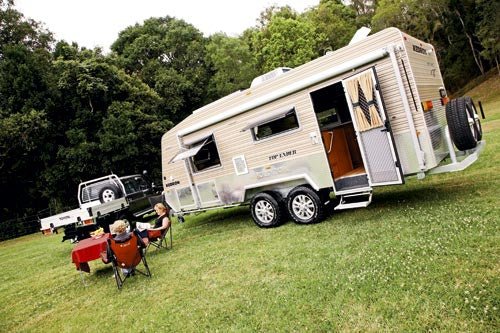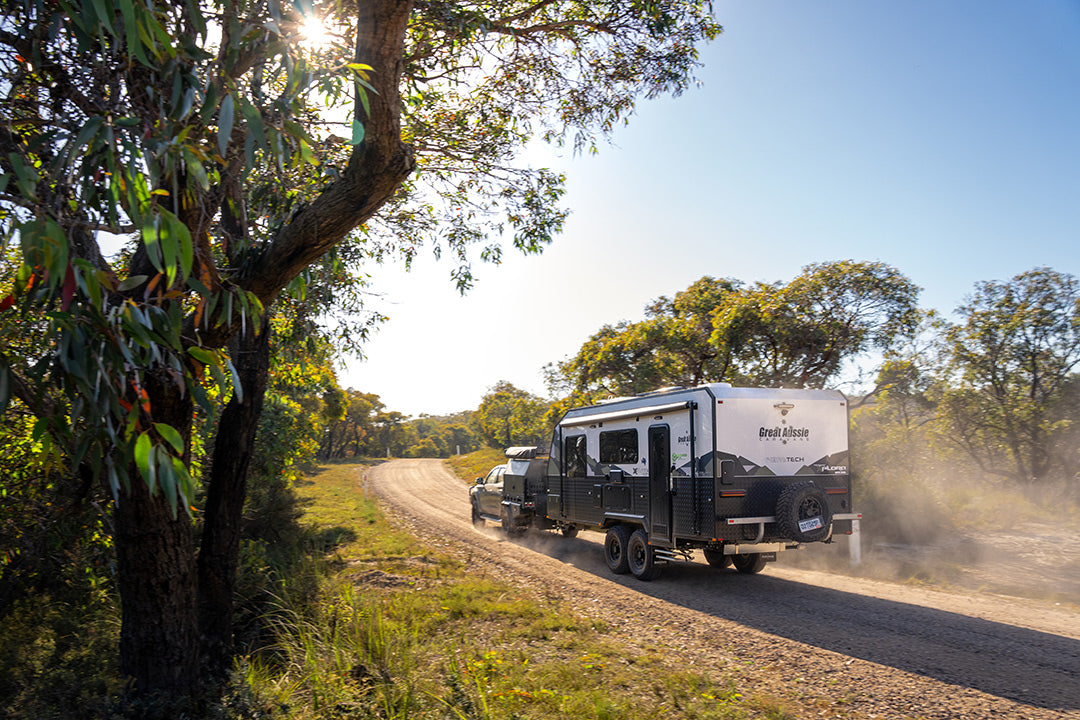Kedron Caravans Top Ender Review

· 6.4m (21ft) offroad caravan
· Self-contained for remote travel
· Mid to large-sized tow vehicle required
'Offroad' is a term that gets bandied around a little too readily. A few manufacturers think that fitting beefed up, raised suspension to a van makes it offroad and there are some buyers who consider themselves offroaders because they travel on well-graded dirt roads. But, to be fair to the manufacturers and dealers, there are now a variety of definitions that can be used to describe a van's potential. Terms such 'rough road' and 'national park roads' have also come into use.
Kedron Caravans has no doubt about its offroad classification - and anyone who has seen any of the Gall Boys DVDs will understand that. Kedron's latest Top Ender caravan is built for offroad use and this is clear from both the chassis and the body construction.
Kedron caravans, such as the Top Ender, are built for serious travelling, both rough and smooth. With a length of 6.4m (21ft) and an ATM of 3500kg, the Top Ender is no lightweight, but it is designed with a specific purpose in mind.
Like all Kedron vans, the Topender is built on a hot-dipped galvanised chassis that has tandem 100x50mm (4x2in) rails running the entire length of the van. Designed to Kedron requirements, the Cruisemaster independent suspension has airbags, trailing arms and two shock absorbers per wheel. The brakes are 12in and designed with flush plugs in case they get wet in creek crossings. Fitted between the chassis rails are three polyethylene 100L water tanks, while side protection bars are fitted along the side of the van.
The walls are secured to the chassis by using a Z channel recess in which they are 'huck' bolted (a collared bolt that has a circular thread that's clamped on) downwards and sideways. This creates a very secure base. The furniture inside the van is then glued and screwed through the base for added strength.
Cupboards and pine frame structures have increased support and the front frame is crafted from solid Tasmanian oak, as are the drawer fronts and doors. These are mitred and have extra V-nailing for strength.
The drawer runners are steel sided, and the bases are made from solid benchtop-style ply. Experience in rough corrugations has shown that the weight of cooking utensils and food tins bouncing around inside drawers can have a negative effect without a good base. Timber strips are used on the inside of the drawers to minimise movement when the drawer is closed. All the door and drawer catches are a push and twist positive lock style. Appliances such as the fridge and microwave are secured with powder-coated angle brackets and stainless steels screws to prevent them moving while the van is in motion.
In keeping with the chassis design, the body has a full aluminium frame that's fixed together with Henrob punch pins, rather than conventional rivets, and the roof frame is fully welded. Aluminium cladding is used for the exterior finish and, naturally, the lower part of the body is protected by aluminium checkerplate panels. A padded cover is used for the top half of the front of the van, including the front window. The van also has all the usual items such as Seitz double-glazed hopper windows, Camec triple-locker door, wall/grab-handle lights and an awning.
At the business end, a McHitch coupling keeps the van on the tow hitch, while allowing plenty of articulation. Also on the drawbar are two 9kg gas cylinders, two jerry can holders, a diesel tank for the heater, mains tap and mesh between the rails for off-ground storage. At the rear is a serious looking bumper that provides rear drag protection. It is also the mounting point for two spare wheels.
All the external storage is at the front of the van with a front boot and a three-quarter tunnel boot with a slide-out generator. A second compartment on the nearside is designed to house the likes of a slide-out fridge. There are three 120Ah deep-cycle batteries in the boot and, in addition to a 40A mains charger, there are three 135W solar panels.
INSIDE STYLE
The Top Ender might be built for the rough stuff but there is nothing rough about the internal décor. It has a de rigueur layout with a front bedroom, rear bathroom, nearside dinette and offside kitchen. Windows all round give a very light and breezy atmosphere.
It's good that the Top Ender has a large load capacity of 630kg because the internal storage is very generous. In addition to the usual inclusions, there is a good-sized cupboard/cabinet between the dinette and bedroom, four drawers fitted under the bed and drawers under both dinette seats. A front-loading washing machine, often located in the bathroom, is fitted under the kitchen bench. That increases the benchtop space but reduces the kitchen storage area. The flipside of this is a slightly smaller bathroom, but that's not such a bad thing.
The kitchen contains all the usual requirements - four-burner cooktop, stainless steel sink, microwave and a generous 215L Waeco fridge. General storage is a mixture of drawers, cupboards and good-sized overhead lockers.
On the opposite side, the leather-upholstered dinette with its tri-fold table offers all the basics for comfortable seating and dining, plus under-seat drawers and table level power-point. Although there's a TV antenna connection, there isn't a 12V socket for battery charging without 240V mains power.
In the forward compartment, the bedroom has large windows, which do much for the perception of space but items such the external storage bins take up bedside space and the under-bed storage area.
Like the rest of the van, the rear bathroom has been built with the full kit. In addition to the nearside shower cubicle and offside cassette toilet, there's a generous amount of cupboard and drawer space. One item of note is the recessed towel and toilet roll holder that is built into the offside partition wall.
When I started my review, there was nearly as much excitement about the tow vehicle as there was about the Top Ender. The Kedron team had managed to get their hands on one of the first Toyota LandCruiser 70 dual cabs to arrive in Australia. The LC 70, being the workaday version of the 200 Series, has been around for some years and is a perfectly capable tow vehicle with its 151kW 4.5L turbodiesel but, to date, has only been available in single cab version. So the good news is that anyone with a penchant for the 70 Series and a dual cab can now get one. In short, it's a good towing vehicle, but not quite as comfortable as the more expensive 200 Series.
THE BOTTOM LINE
Anyone looking for a good offroad van would do well to include the Kedron Top Ender on their shopping list. Like several other specialist manufacturers, it's the result of some serious offroad testing.
Although the Gall Boys DVDs might look like the team are always having fun, there is no doubt that their practical experience gets right back to the design team and the factory floor. The Topender is completely fitted out and ready for remote vanning, wherever you choose to go.
I LIKED...
· Good load capacity
· Generous external and internal storage
· Mid-section cabinet
· Washing machine outside bathroom
· Not white but still easy to clean
I WOULD HAVE LIKED...
· Bit less 'timber' panelling
· A 12V socket or two for charging phone batteries, etc.






